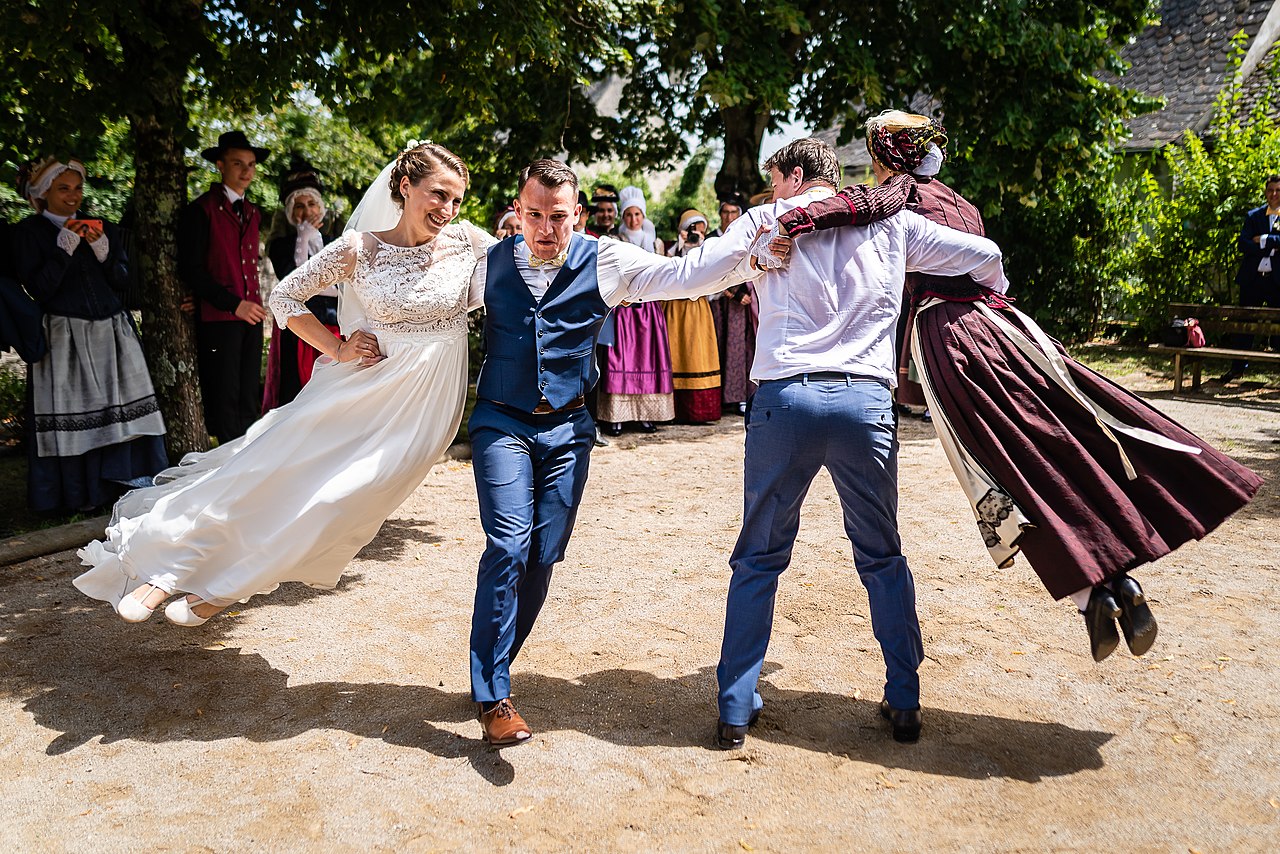French Wedding
French weddings feature a mandatory civil ceremony followed by an optional religious service, with traditional elements like the bride wearing a white dress and holding a bouquet of white orange blossoms. Celebrations include a reception with champagne, "les dragées" (sugared almonds), and a Croquembouche cake cut with a sword, along with unique regional customs such as the noisy "Charivari" and the donkey dance. Post-reception, friends and family create a ruckus to draw the couple out, leading to an impromptu party, and the next morning, the bride drinks from a chamber pot filled with alcohol, continuing the festivities.
French Wedding
The same as in many other countries French bride usually wears white wedding dress ("la robe de mariée"). Apart from the bride all other women attending the wedding should not wear a white dress. Some brides have a veil (un voile) too. A bride traditionally holds a flower bouquet. Traditionally it is made of white orange blossoms. They symbolize prosperous future and fertility. A groom wears a simple suit or a tuxedo.
Characters present at French weddings are flower boys ("un garçon d'honneur") and girls ("une demoiselle d'honneur"). They have simple duties like for example throwing flower petals in front of the happy couple or holding their wedding rings.
To get married both bride and groom got to have one or two witnesses ("témoins"). So, up to 4 witnesses per wedding. Wedding ceremony must be done in the state office. Religious wedding is only an option after the civil ceremony.
Most religious weddings in France are the Roman Catholic Ones. During ceremony bride and groom sit on red velvet chairs. They are blessed under a silk canopy ("carre"). After the religious ceremony a register is signed by the couple and witnesses.
When getting out of the church people throw rice, grains of wheat, laurel leaves or flower petals at the newlyweds.
At big weddings it is common that Le Vin d'Honneur is organized before the start of the wedding reception ("repas de noces"). People enjoy in various drinks (champagne, wines, cocktails) and canapes. Organizers usually put a table with a guest book ("un livre d'or") and a box where you can put some money that will help the happy couple in their future life.
Wedding receptions are held in restaurants, hotels or at home. There is also an option of renting a party venue owned by the local authorities.
Champagne and different wines are served. Every guest at the wedding reception gets sugared almonds known as "les dragées".
On most French weddings you will be able to try the famous Croquembouche or "une piéce montée" ("assembled piece") as this delicacy is also known. It is believed that it was first made by the chef Antonin Carême (1784-1833). Croquembouche is a cone shaped object made of puffed pastry "balls" filled with vanilla cream.
Each ball has a caramel coating. Balls are kept together with chocolate or some other icing ("ganache"). Croquembouche is often decorated with some fruit or flowers.
Croquembouche has a special way it is cut. The newlyweds use a sword to do it. At the same time bridesmaid use the table cloth to catch the falling pieces.
During wedding reception toasts are proposed. Traditionally the newlyweds drink out of "Coupe de Mariage" like this toasting cup with two handles is known.
After the wedding reception the newlyweds go to their home to spend their first night together. But they won't be able to do it that easy. It is because their friends and relatives will perform so called Charivari. They use pots and pans to create terrible noise. Bride and groom are forced to get out. They invite everyone inside. A new party with lot of drink and food can begin.
There are wedding traditions typical for some French regions. The Vendée department in the Pays-de-la-Loire region located in the west of France has an unusual wedding dance. Bride and groom get a huge brioche. They and other dancers have to hold it and dance.

In the Aveyron department in the north-east of the Midi-Pyrenees region of southern France and some other parts of the country there is a tradition known as the donkey dance. The happy couple uses a donkey-drawn cart to travel through a village and inform other people of the wedding.
In the early morning of the next day people carry a chamber pot and try to find the newlyweds. When they find them the bride has to drink what is inside the chamber pot. Then the groom and other people have to do the same. The chamber pot is filled with alcohol, spices or something else.
References
Camille Chevalier-Karfis, What to expect at a typical French
wedding?
http://www.frenchtoday.com/blog/expect-typical-french-wedding
Wedding traditions in France
http://www.frenchentree.com/living-in-france/getting-married/wedding-traditions-in-france/
Croquembouche
http://en.wikipedia.org/wiki/Croquembouche
French Wedding Traditions
http://flyawaybride.com/french-wedding-traditions/
French Wedding Traditions
http://www.worldweddingtraditions.net/french-wedding-traditions/
Image(s)
Croquembouche (photo by Eric Baker, Wikimedia)
https://commons.wikimedia.org/wiki/File:Croquembouche_wedding_cake.jpg
Creative Commons:
File:Paris from the Arc de Triomphe, 17 October 2019.jpg
File:Danse de mariage traditionnel aveyronnais (France).jpg